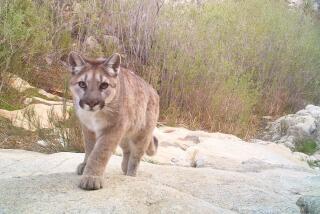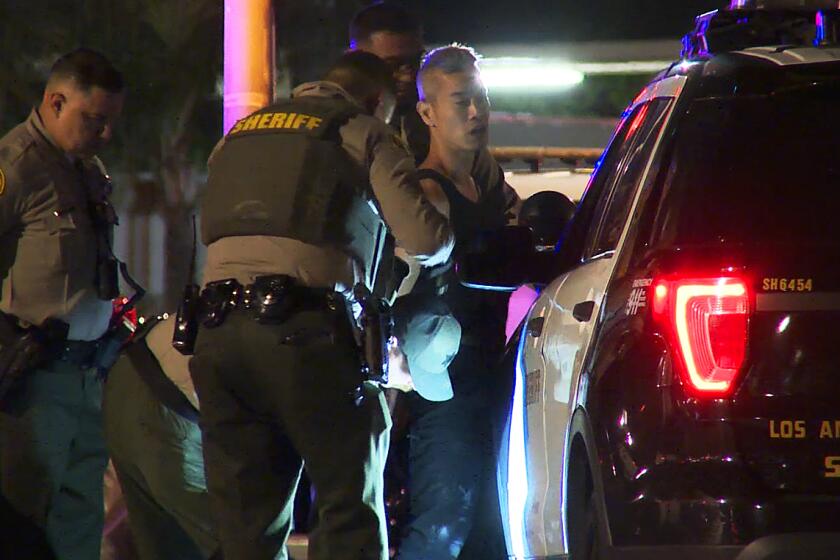Mystery shooter kills coyote in Silver Lake
The “coyotecide” happened on a cool June morning on Fernwood Avenue.
Mike Parson was putting on his shoes to go for a walk with his dog in their Silver Lake neighborhood, just a few miles from Griffith Park, when he heard a loud thump.
For the record:
8:43 p.m. July 1, 2016A previous version of this article referred to the Department of Animal Services as the Department of Animal Regulation. Derek Brown is the assistant general manager at the Department of Animal Services.
Minutes later, he saw a coyote lying in the street in front of his parked truck. The coyote appeared to be dead, but it didn’t look as if a car hit it.
Instead, a mystery sniper took the coyote out.
Los Angeles Police Sgt. John Gutierrez said there were no suspects and it was unclear why the coyote was shot. He said he was sure it was not shot by a Los Angeles Police Department officer or another city employee or official. Gutierrez said the department’s Animal Cruelty Task Force is looking into the shooting. The Department of Animal Services is also investigating.
Despite all the questions, some neighbors believed the killing was just the latest example of residents’ frustration with coyotes in Silver Lake. The neighborhood social network Nextdoor has blown up with tips for managing increasingly bold coyotes, and residents said that coyote sightings in the middle of the street or on front lawns are common.
“If you spent a night here, you’d see one,” said Vanessa Knutsen, who lives a few houses down from where the shooting happened. Just a month ago, Knutsen was coming back from walking her dog, Shaolin, when she saw two coyotes on a triangle of grass opposite her house.
“I scooped up Shao and ran back down” to the main street, Knutsen said.
Coyotes are native to Southern California, and the California Department of Fish and Wildlife has been documenting human-coyote conflicts over three decades.
But in a report presented to the L.A. City Council this week, the Department of Animal Services said its agency, the California Department of Fish and Wildlife and National Park Service had reached a consensus that the coyote population has not grown. The fish and wildlife department estimates the statewide population to be between 250,000 and 750,000.
I don’t want to say it’s completely lost its fear of people. But it’s definitely more bold than the general coyote.
— Justin Brown, biologist with the National Park Service
“They’re not coming from anywhere, they’re just here,” said Niamh Quinn, an advisor at the University of California Division of Agriculture and Natural Resources who specializes in managing human-wildlife conflict. “They’re now established in urban communities and they’re reproducing successfully.”
Justin Brown, a biologist with the National Park Service, said: “I don’t want to say it’s completely lost its fear of people. But it’s definitely more bold than the general coyote.”
Derek Brown, assistant general manager at the Department of Animal Services, said his agency and others have received a higher volume of calls about coyotes in the last year, but he attributed that to social media, noting that many calls are about the same coyote.
Dispatchers at private animal control companies also said they receive frequent calls about coyotes.
Citing data from the L.A. County Department of Public Health, the Daily Breeze reported that coyote attacks on humans increased to 15 in 2015, up from two in 2011. When Quinn recently aggregated and analyzed data from coyote reports across nine counties in Southern California, she found that 32% of the reports involved human-coyote conflict, including bites and attacks, compared with 11 or 13% in other cities.
On Armstrong Avenue, close to the Silver Lake Reservoir, residents described uncomfortable close encounters.
“We’ve had them on our front lawn, 10 feet from the front of the house,” said Miele Adler, who owns a large dog and three cats. “We’ve had a bunch of cats taken.”
Adler said she has stopped letting her cats go outdoors, and she also worries about her children, including a toddler and a 5-week-old baby. “The kids, obviously that’s a concern,” she said. “If they can take a dog that’s my dog’s size, easily they could get taken.”
Adler’s husband, Zoroan Danilovic, described a small pack of coyotes that loiters across the street from their house in the early mornings when he takes their dog out. He said he bangs on empty tomato cans to ward them off.
“I love coyotes,” he said, “but I love my dog more.”
Some residents assumed the coyotes’ increasingly aggressive behavior was the result of food and water shortages in the nearby hills, but experts said it’s simpler than that.
“The coyote is going to try to expend the least amount of energy to get the maximum amount of food,” Quinn said. “Why would you stay in a more rural area where you have to go catch a rabbit when you can stick your head in a garbage can and get the same nourishment?”
Brown, the biologist from the National Park Service, also suggested that the recent uptick in reported coyote sightings could be the result of a couple that mated and gave birth to at least three pups under a house in Silver Lake.
“These animals are very protective when it comes to offspring,” he said, adding that dogs might be seen as competition or a risk to coyote pups.
Despite a fear of the coyotes, no one in the Silver Lake neighborhood endorsed the idea of shooting them.
“It’s very disconcerting,” Steven Rowland said. “Are they coyote vigilantes or something?”
Danielle Vega, who has lived in Silver Lake her entire life, said she was saddened to hear that a coyote had been shot. “They’re part of the neighborhood,” she said. “They may be dangerous. But this is their territory. We have to be respectful of them.”
Uli Boege agreed. His dog was bitten by a coyote a few months ago during a walk at the top of Fernwood Avenue. “It was neglect on my side,” Boege said, adding that he takes extra care now when he walks his dog and doesn’t let him run outside in the early morning or at night, when coyotes are most likely to roam.
Boege, who is originally from Germany, said coyotes are part of the attraction of California. “I’m glad we still live in a semi-wilderness. If you cannot get adjusted to it, leave,” he said.
In its report to the City Council, the Department of Animal Services gave similar advice, albeit in milder terms.
“The best approach to responsible coyote management or ‘control’ is ongoing education on how to co-exist with indigenous wildlife,” the report stated.
That would almost certainly preclude shooting at the coyotes – and especially in a neighborhood.
Twitter: @AgrawalNina
ALSO
Bay Area shelter admits it mistakenly euthanized adoptable pit bull named Barbie
Lawyer in Led Zeppelin-Spirit trial suspended for ‘serious misconduct’ in earlier case
Pro-ISIS group threatens LAX attack; security on alert, but officials question credibility of threat
More to Read
Start your day right
Sign up for Essential California for news, features and recommendations from the L.A. Times and beyond in your inbox six days a week.
You may occasionally receive promotional content from the Los Angeles Times.







